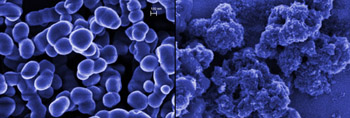Oct 27 2011
Dopamine deficiency is indicative of serious diseases of the nervous system. Tests of dopamine concentration - being usually very low in physiological fluids - are expensive and require specialised equipment that is unavailable in doctor's offices.
This situation may change due to a recent invention from the Institute of Physical Chemistry of the Polish Academy of Sciences in Warsaw. New electrodes coated with carbon nanoparticles deposited on silicate submicroparticles allow to detect dopamine in solutions easily and at low cost, even in the presence of interferences.
 Microscope images of pure silicate submicroparticles (left) and those coated with carbon nanoparticles (right). (Source: IPC PAS)
Microscope images of pure silicate submicroparticles (left) and those coated with carbon nanoparticles (right). (Source: IPC PAS)
Researchers at the Institute of Physical Chemistry of the Polish Academy of Sciences (IPC PAS) have developed electrodes coated with carbon nanoparticles deposited on silicate submicroparticles. The electrodes have been successfully applied to determine dopamine concentration in solutions in the presence of uric and ascorbic acids, and paracetamol, the substances interfering with dopamine analysis. The developed method of dopamine detection opens the way to low cost and quick medical tests that could be used by physicians in their offices to determine with high likelihood if a patient suffers from popular nervous system diseases, such as Parkinson's disease.
The electrodes developed at Institute of Physical Chemistry of the PAS are composed of alternate layers of silicate submicroparticles and carbon nanoparticles. The silicate submicroparticles are from 100 to 300 nanometer (billionth parts of meter) in size. As nonconductive, they are used only as a framework extending the electrode surface. The silicate particles are densely coated with carbon nanoparticles (from 8 to 18 nm in size) that form the actual conductive working surface.
The fabrication of electrodes with new coatings is low cost. The electrodes are alternately immersed for a few seconds in appropriately prepared suspensions, one containing silicate submicroparticles and the other - carbon nanoparticles. "Carbon nanoparticles have negatively charged functional groups, and the silicates positively charged ones. The electrostatic interactions between them are quite strong. We checked that by multiple repeating of the immersion a 'sandwich' consisting of up to 24 layers can be obtained on the electrode surface", describes Anna Celebañska, a PhD student at the IPC PAS.
The researchers from the Institute of Physical Chemistry of the PAS have applied the new electrodes for dopamine sensing in solutions.
Dopamine deficiency is characteristic for, i.a., Parkinson's disease and therefore the detection of the deficiency is of essential medical importance. This, however, is not simple, as dopamine concentration in body fluids, even in healthy individuals, is very low. Moreover, samples containing dopamine usually include other compounds such as uric and ascorbic acid. Both compounds generate signals similar to those produced by dopamine, and they are present at thousand-fold higher concentrations.
To test dopamine concentration using the new method, the electrodes with carbon nanoparticles are immersed in an appropriately prepared solution containing the sample, and then electric potential is applied. Dopamine is electrochemically active and can be oxidised by appropriately adjusting the potential value. Unfortunately, dopamine signal is usually masked by signals originating from ascorbic and uric acids. The carbon nanoparticles on the electrode surfaces change, however, the potential values at which both acids are oxidised. Consequently, the peaks in the plot are separated and the signal from dopamine becomes visible.
"The results of the completed tests turned out very good. Our method is among the most sensitive methods for dopamine sensing. It allows to detect dopamine at concentrations as low as 10-7 mole per liter in the presence of interferences at concentrations up to 10-3 mole per liter", says Celebañska.
The present methods of dopamine sensing are expensive and require specialized equipment, but at the same time relatively cheap, palm-size instruments for detection of chemicals are available on the market. If they would be equipped with new electrodes and popularized in doctor's offices, a patient might learn about his/her illness before leaving the doctor's office.
Dopamine sensing with new electrodes is possible down to concentrations corresponding to those in body fluids of a healthy individual. Lower concentrations that are characteristic for sick individuals will not be precisely determined and the detector will not work. "The method has a natural detection threshold, and that's why we can conclude on dopamine deficiency in the body. How large is the actual deficiency? At present we cannot answer the question. We hope, however, for further increase in the method's sensitivity", states Prof. Marcin Opa³³o from IPC PAS.
The electrodes coated with carbon nanoparticles deposited on polysilicates have been developed under the project "Quantum semiconductor nanostructures for applications in biology and medicine". The over 73 million PLN project is funded in 85% from the European Regional Development Fund under the Innovative Economy Operational Programme 2007-2013. The main participants to the project are the Institute of Physics of the PAS (coordinating body), the Institute of Physical Chemistry of the PAS and the Institute of High Pressure Physics of the PAS. The results of the study have been published in the journal "Biosensors and Bioelectronics". The publication was preceded by a patent application.